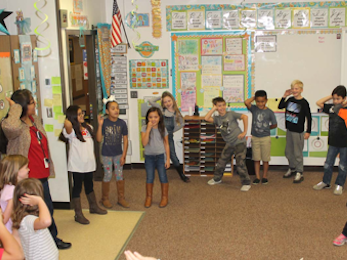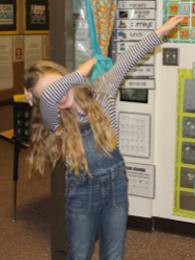All Art Lessons
SUBJECTS
GRADE
Show Results
Statue Stories with Rory’s Story Cubes

Lesson Summary
- Create a story with a beginning, middle, and end, using Rory’s Story Cubes.
- Act out the story by performing five poses/frozen images.
Lesson Plan and Procedure
Lesson Key Facts
- Grade(s): 4, 5, 6
- Subject(s): Drama, English Language Arts
- Duration of lesson: 45 minutes
- Author(s): Haley Flanders Anderson
Note: This activity is intentionally designed for classes just starting drama and storytelling. No prior knowledge of or vocabulary from either subject is needed.
Warm-Up/Hook
Begin the warm-up by having the students stand in a circle.
Teacher: We are going to play a game called “Strike a Pose.” I am going to say my name with an animated voice and strike a funny pose as I speak. Then everyone will copy me by saying my name in the same voice I used and striking the same pose. We are going to go around the circle, and each of you will have a chance to do the same with your name. Get creative with your voice and body. Try to do something different from what everyone else does.
Complete this activity, starting with you, until everyone has had a turn.



Reflection
Teacher: How can this game warm us up for a drama activity? (Listen to responses from students.) It awakens our brains, bodies, and voices, and it teaches us to be creative and spontaneous.
Introduction
Teacher: In today’s activity, like our game, you will create poses with your bodies to act out an original short story. In your groups, you will also use Rory’s Story Cubes.
 Show the cubes to the class. If you have them already sorted into cups (optional), just show the students the three you put in that cup. There are four types of cubes (refer to the “Equipment and Materials Needed” section). It is recommended that you mix and match them. If you have only one set, give one cube to each group to use.
Show the cubes to the class. If you have them already sorted into cups (optional), just show the students the three you put in that cup. There are four types of cubes (refer to the “Equipment and Materials Needed” section). It is recommended that you mix and match them. If you have only one set, give one cube to each group to use.
Teacher: Each group will receive three cubes. Your group will roll the cubes and create a short story based on the cube images. Your story will have five complete sentences: a sentence for a beginning, three sentences for the middle, and a sentence for the ending. However, you will not be reading the sentences you write down when you perform. Instead, you will be acting out each sentence through poses, also known as frozen images. The class will then guess what your story is about.
Instruction/Rehearsal
Teacher: I will read you a sample story, using the template on your worksheet. "Cube #1 shows a cell phone. Cube #2 shows a person shaking a wrapped present by his or her ear. Cube #3 shows a crown. Beginning sentence: The king receives a mysterious present from a stranger wearing a hood. Middle sentences: The king holds the present to his ear while the stranger, who has turned around, talks quietly on her cell phone. The king opens his present and it is a remote-control helicopter that flies into the air. The helicopter drops a note and the king reads the card, which says, “Happy birthday!” Ending sentence(s): The stranger hangs up her cell phone and removes her hood, revealing the she is the daughter of the king. They hug."
Notes on casting and props: Student #1 plays the king. Student #2 plays the stranger/daughter. Student #3 plays the helicopter. The only prop is a note that says, “Happy birthday!”
Split the class into groups of three to four students. Answer any questions students may have about the process. Give each group a worksheet, three story cubes, and some time to write and rehearse.
Teacher: As you write and rehearse, use your imagination and focus on creating poses that are specific enough to tell your story. Use descriptive language and provide all details in a clear, orderly sequence. Consider how to animate your face and body to help your audience figure out your story. Focus on distinct body poses and strong facial expressions. Use basic props you find in the classroom.
Activity/Performance 
Invite the class to gather and watch each group perform. It is best to number the groups beforehand, so the scene transitions run smoothly. As they perform, the teacher directs by saying, “Pose 1, 2, 3, 4, and 5,” so they know when to transition. Have the audience guess what the scene was about. The group reads or explains their story if no one guesses correctly. As students perform, the audience can write down what they think the story is to help them remember the sequence.
Conclusion
Teacher: What was fun about this activity? What was difficult? How did this help us become better storytellers and performers? Why does a story need a beginning, a middle, and an end?
It is recommended that you leave the cube sets out in the classroom, so the students can access them during appropriate times, such as creative writing time, reading time, or inside recess.
Learning Objectives
- Establish a situation and characters who respond to actions.
- Use descriptions and concrete words.
- Provide a conclusion.
- Develop imagination.
- Write a script that focuses on the six questions of storytelling.
- Define roles and work in a group.
- Communicate character and story through physicality.
- Demonstrate audience skills.
Utah State Board of Education Standards
This lesson can be used to meet standards in many grades and subject areas. We will highlight one grade’s standards to give an example of application.
Grade 4 English Language Arts
- Writing Standard 3: Write narratives to develop real or imagined experiences or events using effective technique, descriptive details, and clear event sequences.
- Orient the reader by establishing a situation and introducing a narrator and/or characters; organize an event sequence that unfolds naturally.
- Use dialogue and description to develop experiences and events or show the responses of characters to situations.
- Use concrete words and phrases and sensory details to convey experiences and events precisely.
- Provide a conclusion that follows from the narrated experiences or events.
Grade 4 Drama
- Standard 4.T.CR.1: Develop imagination to create artistic ideas and work.
- Standard 4.T.CR.3: Write or record simple dramas that include the five Ws of who, what, where, when and why.
- Standard 4.T.CR.4: Define roles, identify responsibilities, and participate in group decision making.
- Standard 4.T.CR.5: Create character through imagination, physical movement, gesture, sound and/or speech and facial expression.
- Standard 4.T.CR.7: Recognize that participating in the rehearsal process is necessary to refine and revise.
- Standard 4.T.P.3: Observe, listen, and respond in character to other actors throughout a scripted or improvised scene.
- Standard 4.T.P.4: Communicate meaning using the body through space, shape, energy and gesture.
- Standard 4.T.R.1: Demonstrate audience skills of observing attentively and responding appropriately.
Equipment and Materials Needed
- Pencils
- Paper cups (optional, one per group)
- “Statue Stories with Rory’s Story Cubes” worksheet with sample (one per group)
- Rory’s Story Cubes (nine cubes in a box, preferably three cubes per group)
- Original set (orange box)
- Voyages (green box)
- Actions (blue box)
- Fantasia (pink box)
Additional Resources
- Visit the Rory’s Story Cubes website to buy the four sets and learn about other sets and ideas for creating stories with the cubes. They have Max sets for the visually impaired, ways to mix cubes with other themes, and Storyworld cubes for Batman, Scooby Doo, and many more characters. Here is the website: https://www.storycubes.com/
- Here are some glow-in-the-dark cubes by Imagination Generation, perfect for telling scary tales and ghost stories: https://www.amazon.com/gp/product/B0187YFP5U/ref=oh_aui_search_detailpage?ie=UTF8&psc=1
- For help with sentence starters, use the Learning Resources Writing Prompt Cubes: https://www.amazon.com/Learning-Resources-Writing-Prompt-Cubes/dp/B000URFTJ0
Image References
Image 1: https://www.shutterstock.com/image-photo/childhood-fashion-people-concept-portrait-happy-1730970871
Image 2–5: Haley Flanders Anderson.

www.education.byu.edu/arts/lessons
 Download
Download